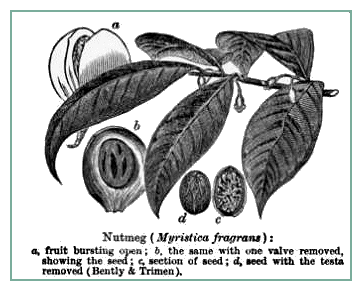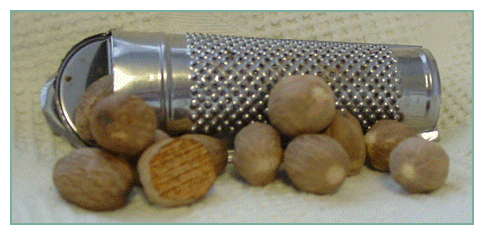nutmeg

The kernel of the fruit of the tree called Myristica moschata, or M. aromatica, a native of the Molucca islands, but cultivated in many parts of the East Indies. This fruit is a nearly spherical drupe, of the size of a pear, of a yellowish color without, and almost white within. This opens into two nearly equal, longitudinal calves, inclosing the nut surrounded by its arillus, which is mace. The nut is oval, the shell very hard, and dark-brown. This immediately envelops the kernel, which is the nutmeg, as commonly sold in the shops. The nutmeg is an aromatic, very grateful to the taste and smell, and much used in cookery. — Webster, 1882
 And [Mother] put a thick slice of birds’-nest pudding on his bare plate, and handed him the pitcher of sweetened cream speckled with nutmeg. -Farmer Boy, Chapter 6, Filling the Ice-House
And [Mother] put a thick slice of birds’-nest pudding on his bare plate, and handed him the pitcher of sweetened cream speckled with nutmeg. -Farmer Boy, Chapter 6, Filling the Ice-House
 This well-known and favorite spice is the kernel – mostly consisting of the albumen – of the fruit of several species of Myristica. This genus belongs to a natural order of exogens called Myristicacæ, which contains about forty species, all tropical trees or shrubs, natives of Asia, Madagascar, and America. They generally have red juice, or a juice which becomes red on exposure to air. The leaves are alternate and without stipules. The flowers are unisexual, the perianth generally trifid, the filaments united into a column. The fruit is succulent, yet opens like a capsule by two valves. The seed is nut-like, covered with a laciniated fleshy aril, the albumen penetrated by the membranous covering. All the species are more or less aromatic in all their parts; their juice is styptic and somewhat acrid; the albumen and aril contain both a fixed as an essential oil, and those of some species are used as spices.
This well-known and favorite spice is the kernel – mostly consisting of the albumen – of the fruit of several species of Myristica. This genus belongs to a natural order of exogens called Myristicacæ, which contains about forty species, all tropical trees or shrubs, natives of Asia, Madagascar, and America. They generally have red juice, or a juice which becomes red on exposure to air. The leaves are alternate and without stipules. The flowers are unisexual, the perianth generally trifid, the filaments united into a column. The fruit is succulent, yet opens like a capsule by two valves. The seed is nut-like, covered with a laciniated fleshy aril, the albumen penetrated by the membranous covering. All the species are more or less aromatic in all their parts; their juice is styptic and somewhat acrid; the albumen and aril contain both a fixed as an essential oil, and those of some species are used as spices.
The species which furnishes the greater part of the nutmegs of commerce is M. fragrans; but the long nutmeg (M. fatua), from the Banda Isles, is not uncommon in our markets. The common nutmeg-tree is about 25 feet in height, with oblong leaves and axillary few-flowered racemes; the fruit is of the same size and appearance of a roundish pear, golden yellow in color when ripe. The fleshy part of the fruit is rather hard, and is of a peculiar consistence, resembling candied fruit; it is often preserved and eaten as a sweetmeat. Within is the nut enveloped in the curious yellowish-red aril, the Mace, under which is a thin shining brown shell, slightly grooved by the pressure of the mace, and within is the kernel or nutmeg.
Up to 1796 the Dutch, being the possessors of the Banda Isles, jealously prevented the nutmeg from being transplanted; but during the British occupation, plants were sent to Penang, India, the West Indies, Brazil, Réunion, where they are not successfully cultivated.
Nutmegs are very liable to the attack of a beetle, which is very destructive, and it is a common practice to give them a coating of lime before shipping them to Europe to kill the vitality of the germ. The nutmeg yields by expression a peculiar yellow fat, called oil of mace, because from its color and flavor it was generally supposed to be derived from mace; and by distillation is obtained an almost colorless essential oil which has very fully the flavor of nutmeg.
Nutmegs are chiefly used as a spice, but medicinally they are stimulant and carminative. They possess narcotic properties, and in large doses produce stupefaction and delirium. Great Britain imports from 300,000 to 700,000 lbs. annually, besides mace to the extent of 60,000 to 80,000 lbs.
The culture of nutmeg is somewhat peculiar. The plantations are always made from seed, and the plants do not produce flowers till they are eight or nine years old. The sexes being on different trees, when the plants are two years old the greater number composing a plantation are headed down and grafted with scions taken from the female tree, a few only being grafted with scions of the male to ensure fecundation.
Other species of Myristica besides those already named yield nutmegs sometimes used, but of very inferior quality. The fruits of several species of Lauracea also resemble nutmegs in their aromatic and other properties, as the cotyledons of Nectandra puchury, the Pichurium beans of commerce, and the fruit of Acrodiclidium camara, a tree of Guiana, the Camara or Ackawai nutmeg. The clove nutmegs of Madagascar are the fruit of Agathophullum aromaticum, and the Brazilian nutmegs of Cryptocarya moschata. All these belong to the order Lauraceæ. The Calabash nutmeg is the fruit of Monodora myristica, of the natural order Anonaceæ. — Chambers’s Encyclopædia: A Dictionary of Universal Knowledge, Vol. VII. (Philadelphia: J.B. Lippincott Company, 1896), 533.
 Nutmeg grater and nutmegs. Note the flattened nutmeg that has been grated. One or two nutmegs are stored beneath the hinged lid at the top of the grater; grated nutmeg falls out the bottom of the grater. This grater is the same design as one owned by Laura Ingalls Wilder and on display at the Laura Ingalls Wilder / Rose Wilder Lane Home and Museum in Mansfield, Missouri. Tour guides have said that the grater at the museum was a wedding present to Laura Ingalls Wilder, but it is not known if this is indeed fact. These graters are commonly sold today.
Nutmeg grater and nutmegs. Note the flattened nutmeg that has been grated. One or two nutmegs are stored beneath the hinged lid at the top of the grater; grated nutmeg falls out the bottom of the grater. This grater is the same design as one owned by Laura Ingalls Wilder and on display at the Laura Ingalls Wilder / Rose Wilder Lane Home and Museum in Mansfield, Missouri. Tour guides have said that the grater at the museum was a wedding present to Laura Ingalls Wilder, but it is not known if this is indeed fact. These graters are commonly sold today.
 Nutmeg Grater For Sale. The advertisement shown here includes a grater similar to Laura’s. In 1894, when this advertisement was printed, such a grater sold for twenty cents. Today, one sells for about five dollars.
Nutmeg Grater For Sale. The advertisement shown here includes a grater similar to Laura’s. In 1894, when this advertisement was printed, such a grater sold for twenty cents. Today, one sells for about five dollars.

nutmeg (FB 6), see also bird’s-nest pudding

